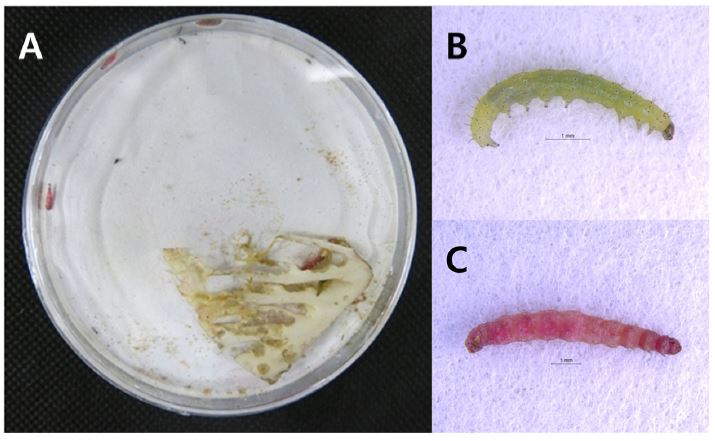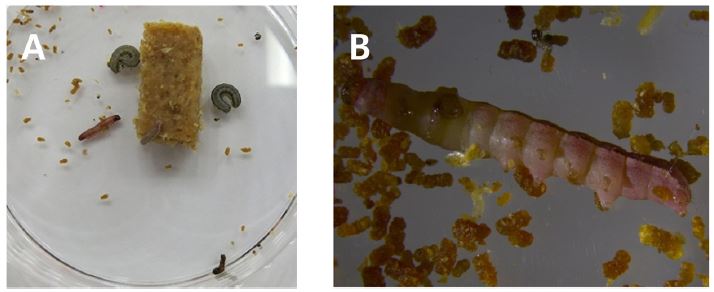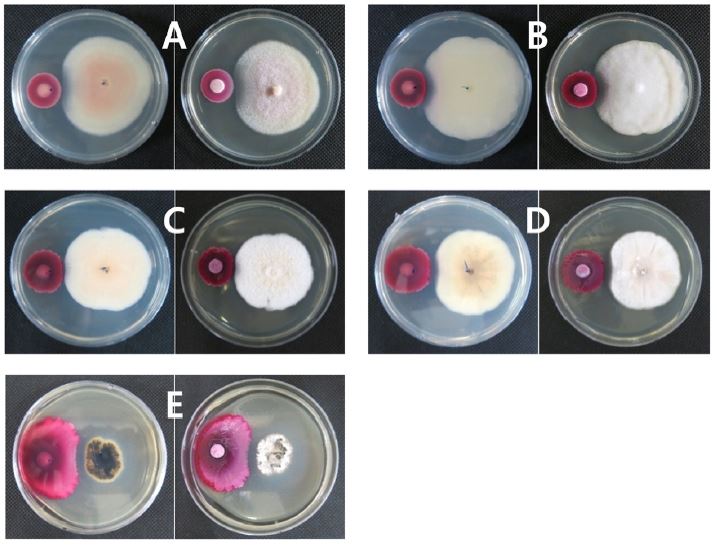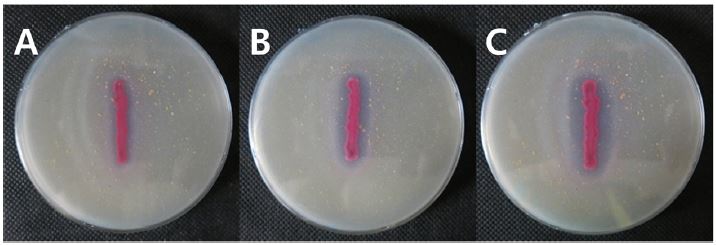
배추좀나방(Plutella xylostella)의 죽은 유충에서 분리한 Serratia marcescens 균주의 생물활성
초록
배추좀나방의 죽은 유충을 사육상자에서 발견하여 죽은 원인을 조사 하였다. 죽은 유충으로부터 세균을 분리하여 생물검정으로 균주를 선발하였다. 선발된 세균의 형태 및 유전자 염기서열을 분석한 결과, Serratia marcescens로 동정되었다. 생물검정을 위하여 S. marcescens균주를 LB배양액으로 배양하여 증식하였다. 배양액을 100배로 희석하였을 때, 배추좀나방 3령 유충에 처리한 결과, 처리 2일 후에 100%의 사충률을 보였으며, 상청액만으로 처리하였을 경우에는 10배 희석액에서 86.6%의 사충률을 나타냈다. 또한 파밤나방유충에 접촉독성은 20%의 사충율을 나타냈고, 섭식독성은 8%의 효과를 보였으며, 접촉독성과 섭식독성을 동시에 수행하였을 경우에는 28%의 사충률을 보였다. 또한 국내 5개의 주요 식물병원성균에 대한 항균활성 검정에서 Fusarium oxysporum에 대해서는 4.7%, Rhizoctonia solani은 11.3%, Phytophthora capsici은 15.7%, Colletotrichum gloeosporioides은 20% 그리고 Sclerotinias clerotiorum은 42.6%의 control value를 보였다. 또한 S. marcescens 균주에 대하여 단백질과 chitin분해능력을 검토하였다.
Abstract
The cause of death was investigated with several dead cabbage moth larvae in breeding box. Bacterial strains were isolated and selected from the dead larvae by bioassay. One of them was identified as Serratia marcescens used by morphological characteristics and gene sequencing. S. marcescens were cultured by Luria Bertani (LB) media broth for bioassay. When 100-fold dilution of culture broth to third larvae of diamondback moth, Plutella xylostella, it was showed a 100% mortality at 2 days after treatment, and only 10-fold dilution of supernatant liquid was showed 86.6% mortality. When the culture broth of S. marcescens was applied to the larvae of beet armyworm, Spodoptera exigua, contact and feeding toxicity were 20 and 8% of mortality, respectively. Otherwise, when the culture broth of S. marcescens was applied to 5 major plant pathogens, antibacterial activities against Fusarium oxysporum, Rhizoctonia solani, Colletotrichum gloeosporioides, Phytophthora capsici and Sclerotinias clerotiorum were 4.7, 11.3, 20, 15.7 and 42.6%, respectively. Also, degradation ability of S. marcescens against protein and chitin were examined.
Keywords:
Bioassay, Chitin, Plutella xylostella, Serratia marcescens, Spodoptera exigua키워드:
배추좀나방, 파밤나방, 생물활성, Chitin분해능력서 론
아시아지역에서 십자화과 채소의 재배면적은 220만ha 정도이고, 채소 생산량의 50%를 차지할 정도로 우리들에게 매우 중요한 경제적 작물이다(Sivapragasam et al., 1997). 이러한 십자화과 작물에 가장 유해한 해충의 하나인 배추좀나방(Plutella xylostella)은 방제비용이 전 세계적으로 연간 약 10억 달러가 넘게 사용되고 있다(Talekar and Shelton, 1993; Sivapragasam et al., 1997). 성충은 해질녘부터 밤까지 활동하며 주로 이때 교배를 하고 암컷 나방은 교배 후 곧 알을 낳는데 4일간 11~188개의 알을 낳는다(Talekar and Shelton, 1993). 대부분은 오후 7~8시 사이에 알을 낳는데(Pivnick et al., 1990a), 산란 조건으로서 잎 표면의 휘발성 물질, 2차 대사산물, 온도, 돌기구조 그리고 왁스 등이 영향을 미치고 있다(Tabashnik, 1985; Uematsu and Sakanoshita, 1989; Pivnick, et al., 1990b). 알에서의 부화는 5~6일 정도 소요되는데, 주로 온도의 영향을 많이 받는다. 부화 후 곧 잎을 먹기 시작하는 1령 유충은 다공성 엽육 조직을 먹기 시작하며, 노령 유충은 잎 전체를 먹는다. 십자화과에 피해를 주는 유충의 생활사는 1령이 4일, 2령이 4일, 3령은 5일, 4령은 5일이나 6일로서 18일정도에 번데기로 된다(Talekar and Shelton, 1993).
배추좀나방을 방제하는 방법에는 재배적 방제, 저항성 작물, 성페로몬, 생물적 방제, 화학적 방제 그리고 종합적 방제 등이 있다(Talekar and Shelton, 1993). 이러한 방제 방법 중 대부분의 소농과 대농 모두 화학적 방제법을 주로 사용하기 때문에 살충제의 오남용으로 저항성 배추좀나방이 발현하여 방제에 어려움을 격고 있다(Cho et al., 2001). 배추좀나방은 전 세계적으로 DDT, organophosphorus, carbamate, pyrethroid 등 화학적 살충제에 대한 저항성이 보고되었다(Ankersmit 1953; Sun et al., 1986). 국내에서도 organophosphorus와 carbamate(Cho et al., 2001), 그리고 chlorpyrifos에 대해서 저항성이 보고되었다(Kim et al., 2003).
한편, 세계적으로 1970년대에는 대표적 미생물적 살충제인 Bacillus thuringiensis를 이용한 방제가 처음 소개되었는데 이 당시엔 효과가 매우 좋았다(Talekar and Shelton, 1993). 하지만 이후 필리핀에서 배추좀나방에 대한 B. thuringiensis의 활성이 낮아졌으며, 저항성이 생겼다고 보고되었다(Kirsch and Schmutterer, 1988). 이후 계속적으로 하와이, 인도네시아, 일본에서도 저항성이 보고되었다(Hama, 1990; Tabashnik et al., 1990; Shelton et al., 1993).
Serratia sp. 세균은 Orthoptera, Isoptera, Coleoptera, Lepidoptera, Hymenoptera, Diptera와 같은 몇 가지 곤충목과 관련되어 있다(Grimont and Grimont, 2006). 그 중 Serratia marcescens는 그람 음성 단간균으로 증식중에 붉은색 항생물질인 prodigiosin을 생성한다(Williams et al., 1956; Hejazi and Falkiner, 1997). 이 천연 물질은 항생물질로 항진균, 항세균, 항선충 그리고 면역억제 등에 효과가 있는 것으로 알려져 있다(Suryawanshi et al., 2015). S. marcescens는 누에나방, 밤나방 그리고 흰점박이꽃무지와 같은 몇 가지 곤충에 복강주입으로 접종했을 때 병원성을 보였고, 모기 유충과 목화 바구미에도 병원성을 보였다(Ourth and Smalley, 1980; Ishii et al., 2014; Kwak et al., 2014; Suryawanshi et al., 2015; Tunaz and Küsek, 2015). S. marcescens가 Aedes aegypti와 Anopheles stephensi의 모기유충에 살충력을 갖는 것이 확인되었고, S. marcescens가 생산하는 항생물질인 prodigiosin이 모기 유충과 번데기를 치사시키는 기작이 밝혀졌다(Patil et al., 2011; Suryawanshi et al., 2015).
또한 Serratia sp. 세균은 길항미생물로서 여러 미생물에 대해 항균작용을 보이는 것으로 알려져 있다(Fadhil et al., 2014; Yang et al., 2014). Serratia sp. 세균은 곤충과 곰팡이에 유해한 exoenzymes인 proteases, gelatinase와 chitinase를 생성한다(Fadhil et al., 2014). Chitin은 절지동물의 외골격과 oomycetes를 제외한 모든 진균의 세포벽 구성 성분이다(Jones et al., 1986). Chitinase는 곤충과 곰팡이의 세포벽을 녹여 Serratia sp. 세균이 독성을 일으키 는데 중요한 작용을 한다(Fadhil et al., 2014). S. marcescens도 이러한 enzyme을 생산하여 체외로 분비하는 것으로 알려져 있는데(Roberts and Cabib, 1982), 그 중 chitinase와 prodigiosin이 곤충에 살충력을 나타내며 곰팡이를 억제하는 것으로 알려져 있다(Monreal and Reese, 1969; Hejazi and Falkiner, 1997; Someya et al., 2001).
따라서 본 연구는 사육 중 배추좀나방 죽은 유충에서 세균을 분리하여 동정하고 접종하여 생물활성을 확인하였다. 그리고 나비목 해충인 파밤나방에 대한 생물 검정을 진행하였다. 또한 십자화과와 가지과에 병원성을 일으키는 곰팡이에 대해 항균능력을 검정하였다.
재료 및 방법
시험곤충
배추좀나방은 충남대학교 응용생물학과 곤충사육실에서 사육하였으며, 사육 조건은 온도 25 ± 2oC, 광조건 16L:8D, 상대습도 50~60%로 열무를 먹이로 공급하며 누대 사육하였다. 파밤나방도 동일한 조건에서 먹이는 인공사료(Goh et al., 1991)를 이용하여 누대 사육하였다.
미생물의 분리 및 동정
곤충사육실에서 사육중이던 배추좀나방의 개체군에서 죽은 유충 12마리를 채집하였다. 죽은 유충의 표면소독은 1% NaClO3에 1분간 침지한 후 70% (w/w)에탄올에 또다시 1분 침지하였다. 그리고 죽은 유충에 남아있는 에탄올은 멸균수로 세척한 뒤 eppendorf tube (Axyzen, Central Avenue Union City. USA)에 멸균수 1 ml에 죽은 유충을 각각 4마리씩 넣어 마쇄 하였다.
마쇄된 혼합액의 상청액 200 μl를 적절하게 희석하여 NA고체배지에 배양하여 세균을 분리하였다. 분리한 세균을 Phase contrast microscope (Olympus BX51)로 형태를 관찰하고, 목원대학교 미생물생태자원연구센터에서 분류동정하였다. 분자생물학적 동정을 위하여 16S rRNA를 PCR 증폭하였으며, Primer는 27F (5'-AGAGTTTGATCCTGGCTCAG-3') primer와 1492R (5'-GGTTACCTTGTTACGACTT-3') primer를 사용하였다. 16S rRNA 유전자 PCR 증폭산물은 PCR Product purification Kit (Qiagen)를 사용하여 정제하였고, PCR 정제산물은 Genetic analyzer 3730xl (Applied biosystems)로 염기서열을 분석하였고, 염기서열은 NCBI/Genebank와 Ribosomal Database Project II (RDP II)의 database에서 상동성 검색을 수행 하였다.
생물활성검정
위에서 분리한 Serratia marcescens 균주를 LB배양액에 배양기간에 따라 5일, 7일 그리고 10일 간격으로 배양하여 배양원액을 배추좀나방에 생물 검정하였다. 또한 이 균주의 살충기작을 일으키는 주요 독소성분이 어디에 포함되어있는지를 확인하기 위해 배양한 원액과 상층액으로 나누어서 각각 시험하였다. 우선 배양액의 시험은 90 mm petri dish에 배추잎을 넣고 배추좀나방을 dish당 5마리씩 접종하였다. 처리방법은 손 스프레이를 사용하여 배양액 300 μl를 분무하였다. 처리 후 24시간 간격으로 치사여부를 확인하였으며, 충체가 빨간색으로 나타나거나 움직임이 없는 것을 죽은 것으로 판단하였다.
파밤나방의 생물검정도 배추좀나방과 동일한 방법으로 수행하였으며, 또한 LB와 chitin 배양액으로 작용기작의 특성을 검토하기 위하여 각각 인공 사료인 먹이에 혼합하여 섭식독성을 시험하였으며, 파밤나방에만 배양액을 살포하는 접촉독성 시험을 하고, 양쪽을 동시에 시험하기 위하여 먹이를 주고 살포를 하는 섭식 및 접촉독성 등 3가지 방법으로 나누어 수행하였다.
식물병원성 곰팡이에 대한 항균활성
위에서 분리한 Serratia marcescens의 식물병원성균에 대한 길항작용은 십자화과에 밑둥썩음병을 일으키는 Rhizoctonia solani 균주, 균핵병을 일으키는 Sclerotinia sclerotiorum 균주, 시들음병을 일으키는 Fusarium oxysporum 균주, 가지과에 역병을 일으키는 Phytophthora capsici 균주, 시들음병을 일으키는 Fusarium oxysporum 균주, 그리고 탄저병을 일으키는 Colletotrichum gloeosporioides 균주 등 총 6종의 식물병원성 곰팡이를 충남대학교 응용생물학과 식물병리학 실험실에서 분양받아 사용하였다.
또한 새로운 균주의 chitin분해 능력을 확인하기 위해 chitin agar (colloidal chitin 0.5%, Na2HPO4 0.2%, KH2PO4 0.1%, NaCl 0.5%, NH4Cl 0.1%, MgSO4 7H2O 0.05%, CaCl2 2H2O 0.05%, Yeast extract 0.05%, bactoagar 2%)plate에 균주를 도말 하여 27oC의 조건으로 배양하였다. Clear zone은 배양 6, 8 그리고 10일 차에 확인하였다. S. marcescens 균주에 의한 식물병원성 곰팡이의 inhibition zone의 길이는 Dogmatic caliper (Mitutoyo)를 사용하여 측정하고 control value를 측정하였다.
R1= 병원성 곰팡이 control의 직경.
R2= S. marcescens에 의해 저해되는 곰팡이의 직경.
결과 및 고찰
최근 국내의 작물보호방향은 유기합성농약에 대한 여러가지 문제점들을 고려 하여 친환경적인 병해충 방제방법의 발전에 힘쓰고 있다. 따라서 이에 필요한 유기농자재의 탐색과 개발 그리고 상업화가 절실하게 요구되고 있다. 유기농자제의 구비조건은 다양하지만 그 중에서 가격이 저가이면서 방제가가 높아야 하고 물량이 안정적으로 공급될 수 있으며 자연환경 및 인축에 안정성의 확보가 최우선이 되어야 한다. 이러한 조건을 갖출 수 있는 유기농자제로서는 식물의 추출물보다는 미생물 유래의 살충제가 우선시 되고 있다. 따라서 본 연구실에서 새로운 미생물 살충제의 탐색과정에서 발견된 미생물의 산업화를 위하여 특성을 검토하였다.
죽은 곤충의 유충으로 분리된 새로운 균주가 유기농자제로서 개발되는 과정 에서 우선 외부 형태적 특성을 phase contrast microscope (Olympus BX51)로 관찰 하였다. 균주의 분리학적 특성을 유전학적으로 구명하기 위하여 16srRNA 염기 서열을 분석한 결과, Serratia marcescens ATCC13880 균주와 99.8%의 상동성으로 나타났다.
Serratia marcescens 균주의 생물활성검정
배추좀나방의 죽은 유충에서 분리한 S. marcescens 균주의 살충활성을 검토하기 위하여 LB배양액에 몇 종류의 해충에 대하여 생물검정을 실시하였다. 생물검정은 Fig. 1A에서 볼 수 있듯이 처리 2일 후부터 감염되어 죽은 배추좀나방의 유충과 번데기가 용화하여 죽은 상태까지 조사했다. Fig. 1B는 대조군의 배추좀나방의 정상적인 유충이며 1C는 감염된 배추좀나방 유충으로 몸 전체가 붉게 변하며 죽었으며 배추좀나방이 번데기로 용화하여도 감염상태가 진행하는 것을 확인 할 수 있었다.
죽은 배추좀나방에서 분리한 균주이므로 S. marcescens 균주의 최고 활성이 높은 10일간 배양액을 배추좀나방 3령 유충에 100배 희석액으로 처리하고 2일 후면 100%의 사충률을 보였다(Table 1). 또한 독성의 특성을 구명하기 위하여 배양액을 원심 분리 하고 나서 상청액만을 배추좀나방에 처리하였을 때 처리 7일 후에 배양 원액은 100% 사망하였고, 10배 희석액에서는 86.6%의 사충률을 보였으며, 무처리로 LB양액만을 처리한 대조구는 모두 살아있었다(Table 1). 결과적으로 배양 원액과 균을 제거한 상청액과의 독성 비교실험에서 균주가 혼재되어 있는 원액이 방제효과가 좋은 것으로 나타났다.

A dead diamondback moth larva after treated by Serratia marcescens strain culture broth. A: 2 days after treatment; B: Normal diamondback moth larva; C: A dead diamondback moth larva infected by Serratia marcescens strain culture medium.

Mortality rate of third larva of the diamondback moth after treated by that is culture broth and supernatant of Serratia marcescens strain in LB medium

An after dead of Spodoptera exigua 3rd instar treated with Serratia marcescens strain broth. A: 3 days after treatment; B: An infected dead Spodoptera exigua larva.
한편 S. marcescens 균주가 나비목 곤충인 파밤나방에도 살충력을 나타내는지 여부를 조사하기 위하여 LB배양액으로 생물 검정하였다. 파밤나방 3령 유충에 섭식, 접촉 그리고 섭식과 접촉 합한 3가지 방법으로 나누어 처리하였을 때 파밤 나방 유충에서도 몸이 붉게 변하여 죽었다. Table 2에서 볼 수 있는 것 같이, LB 배양액의 상청액 만으로 파밤나방 유충에 처리하였을 때, 접촉은 5.3%, 섭식은 0% 그리고 접촉과 섭식은 10.66%의 사충률을 보였다. 반면에 균체가 포함된 배양액 전부를 처리하였을 때, 접촉은 20%, 섭식은 8%, 접촉과 섭식은 28%의 사충률을 확인하였다. 이 결과로 배추좀나방에 비하여 살충 활성은 낮게 나타났고 파밤나방의 결과에서도 상청액보다 균체를 포함한 배양액에서 더 높은 살충 활성을 보였고, 섭식보다는 접촉에서 살충 활성이 높았으며, 접촉과 섭식을 함께 처리하였을 때 높은 사충률을 나타냈다.
선발된 S. marcescens 균주의 chitinase 생성을 유도하기 위해 chitin 배양액으로 파밤나방에 대한 생물활성을 조사하였다. Chitin 배양액의 상청액을 파밤나방 유충에 처리하였을 때 접촉은 4%, 섭식은 1.33% 그리고 접촉과 섭식은 6.66%의 낮은 사충률을 보였다(Table 3). 반면에 S. marcescens 균주가 포함된 chitin 배양액을 처리하였을 때 접촉은 16.0%, 섭식은 10.7% 그리고 접촉과 섭식은 36.0%의 사충률로 나타냈다. 이 결과에서도 chitin 배양액은 LB 배양액에서와 마찬가지로 배양액을 접촉과 섭식을 함께 처리하였을 때 사충률이 가장 높았으며, LB 배양액보다 chitin 배양액에서 26%인데 반하여 36%로 사충률이 약간 높았다. 이러한 결과로서 균체는 exotoxin으로 판단되나 균체도 지속적으로 독소물질을 만들어 내고 있다는 증거로 판단할 수 있는 결과이다.

Mortality rate of Spodoptera exigua larva at 7 days after treatment that is treated each as contact, stomach, contact and stomach for supernatant or/and culture broth of S. marcescens in LB medium
식물병원성 곰팡이에 대한 Serratia marcescens 균주의 항균활성 검정
배추좀나방의 죽은 유충에서 분리된 S. marcescens 균주의 식물병원균에 대한 항균활성을 조사하였다. 농작물의 주요 식물병원성 5종의 곰팡이에 대하여 PDA고체배지상에서 대치 배양하여 Digimatic caliper (Mitutoyo) 로 clear zone을 측정하여 검토하였다.
농작물에 시들음병을 일으키는 F. oxysporum와 PDA 배지상에 접종한 후의 모습은 Fig. 3A에, Fig. 3B는 가지과에 역병을 일으키는 P. capsici 균주와 PDA 배지상에 접종한 배양한 형태이다. Fig. 3C는 십자화과에 밑둥썩음병을 일으키는 R. solani이며, Fig. 3D는 탄저병을 일으키는 C. gloeosporioides이고 그리고 Fig. 3E는 균핵병을 일으키는 S. sclerotiorum과의 생물활성 사진이다. S. marcescens 균주는 5종의 주요 식물병원성 곰팡이의 생육을 뚜렷하게 저해 하지는 못하는 것으로 나타났다. Someya와 Kataoka(2000)은 S. marcescens가 R. solani와 F. oxysporum에 항균력을 나타내며 S. marcescens와 chitin을 함께 처리하였을때 더 큰 효과를 나타낸다고 보고하였다. 이처럼 S. marcescens는 살충뿐만 아니라 어느 정도의 항균능력도 있는 것으로 확인되어 생물적방제에 사용할 수 있을 것으로 보인다.

Replacement culture incubated with Serratia marcescens strain in chitin medium and 5 species plant pathogenic fungi in PDA medium. A: 6 days after replacement culture with Fusarium oxysporum, B: 6 days after replacement culture with Phytophthora capcisi, C: 10 days after replacement culture with Rhizoctonia solani, D: 10 days after replacement culture with Colletotrichum gloeosporioides, E: 28 days after replacement culture with Sclerotinias sclerotiorum.
Serratia marcescens의 chitin분해력
S. marcescens 균주의 chitin 분해력을 조사하기 위해 chitin 고채배지에 균주를 도말하여 clear zone을 조사하였다. Fig. 4A는 배양 6일 후 형태로서 콜로니 주변에서 약간 분해하는 것으로 나타났다. Fig. 4B, C는 각각 배양 8일, 10일 후의 모습으로 뚜렷한 clear zone을 조사되었다.
Roberts와 Selitrennikoff (1988)의 연구에서는 S. marcescens가 chitin agar plate를 분해하는 것을 확인하였으며, 본 연구에서도 분해하는 것을 확인하였다. Flyg와 Xanthopoulos (1983)의 보고에 의하면 S. marcescens가 생산하는 hydrolytic enzymes인 proteases와 hitinase는 곤충에 병원성을 보였다. 이 실험에서 사용한 S. marcescens 균주도 chitinase와 proteases를 생성하여 살충력을 갖는 것을 추측할 수 있었다.
Acknowledgments
본 연구는 2015년도 충남대학교 자체연구비에 의하여 수행 되었으며 이에 감사를 드립니다.
Literature Cited
-
Ankersmit, G., (1953), DDT-resistancein Plutella maculipennis (Curt.) (Lep.) in Java, Bull. Entomol. Res, 44(03), p421-425.
[https://doi.org/10.1017/S0007485300025530]

- Cho, J. M., K. J. Kim, S. M. Kim, D. S. Han, and J. H. Hur, (2001), Diamondback moth (Plutella xylostella L.) resistance to organophosphorus and carbamate insecticides in Kangwon alpine vegetable croplands, Kor. Soc. Pest. Sci, 5(1), p30-35.
- Fadhil, L., K. Abdula, and M. Abdulhussien, (2014), Production of chitinase by Serratia marcescens from soil and its antifungal activity, J. Natural Sci. Res, 4(8), p80-86.
-
Flyg, C., and K. G. Xanthopoulos, (1983), Insect pathogenic properties of Serratia marcescens. Passive and active resistance to insect immunity studied with protease-deficient and phage-resistant mutants, Microbiol, 129(2), p453-464.
[https://doi.org/10.1099/00221287-129-2-453]

- Goh, H. G., D. J. Park, Y. M. Choi, K. M. Choi, and I. S. Park, (1991), The host plants of beet armyworm, Spodoptera exigua (Hbner), (Lepidoptera: Noctuidae) and its occurrence, Kor. J. Appl. Entomol, 30(2), p111-116.
-
Grimont, F., and P. A. Grimont, (2006), The genus Serratia, The prokaryotes, Springer, 6, p219-244.
[https://doi.org/10.1007/0-387-30746-x_11]

- Hama, H., (1990), Insecticide resistance characteristics of diamondback moth, Generations, 1(5), p10.
-
Hejazi, A., and F. Falkiner, (1997), S erratia marcescens, J. Medi. Microbiol, 46(11), p903-912.
[https://doi.org/10.1099/00222615-46-11-903]

-
Ishii, K., A. Tatsuo, H. Takashi, H. Hiroshi, and S. Kazuhisa, (2014), Identification of a Serratia marcescens virulence factor that promotes hemolymph bleeding in the silkworm, Bombyx mori, J. invert. Pathol, 117, p61-67.
[https://doi.org/10.1016/j.jip.2014.02.001]

- Jones, J. D., K. L. Grady, T. V. Suslow, and J. R. Bedbrook, (1986), Isolation and characterization of genes encoding two chitinase enzymes from Serratia marcescens, EMBO J, 5(3), p467.
- Kim, K. G., S. S. Kim, S. M. Kim, and J. H. Hur, (2003), Characteristics of resistance to chlorpyrifos in diamondback-moth (Plutella xylostella L.), Kor. Soc. Pesti. Sci, 7(4), p288-295.
-
Kirsch, K., and H. Schmutterer, (1988), Low efficacy of a Bacillus thuringiensis (Berl.) formulation in controlling the diamondback moth, Plutella xylostella (L.), in the Philippines, J. Appl. Entomol, 105(1-5), p249-255.
[https://doi.org/10.1111/j.1439-0418.1988.tb00183.x]

-
Kwak, K. W., M. S. Han, S. H. Nam, J. Y. Choi, S. H. Lee, Y. C. Cho, and K. H. Park, (2014), Detection of insect pathogen Serratia marcescens in Protaetia brevitarsis seulensis (Kolbe) from Korea, Inter. J. Indust. Entomol, 28(2), p25-31.
[https://doi.org/10.7852/ijie.2014.28.2.25]

-
Monreal, J., and E. T. Reese, (1969), The chitinase of Serratia marcescens, Can. J. Microbiol, 15(7), p689-696.
[https://doi.org/10.1139/m69-122]

-
Ourth, D. D., and D. L. Smalley, (1980), Phagocytic and humoral immunity of the adult cotton boll weevil, Anthonomus grandis (Coleoptera: Curculionidae), to Serratia marcescens, J. invert. Pathol, 36(1), p104-112.
[https://doi.org/10.1016/0022-2011(80)90141-X]

-
Patil, C. D., S. V. Patil, B. K. Salunke, and R. B. Salunkhe, (2011), Prodigiosin produced by Serratia marcescens NMCC46 as a mosquito larvicidal agent against Aedes aegypti and Anopheles stephensi, Parasitol. Res, 109(4), p1179-1187.
[https://doi.org/10.1007/s00436-011-2365-9]

-
Pivnick, K. A., B. J. Jarvis, C. Gillott, G. P. Slater, and E. W. Underhill, (1990a), Daily patterns of reproductive activity and the influence of adult density and exposure to host plants on reproduction in the diamondback moth (Lepidoptera: Plutellidae), Environ. Entomol, 19(3), p587-593.
[https://doi.org/10.1093/ee/19.3.587]

-
Pivnick, K. A., B. J. Jarvis, G. P. Slater, C. Gillott, and E. W. Underhill, (1990b), Attraction of the diamondback moth (Lepidoptera: Plutellidae) to volatiles of oriental mustard: the influence of age, sex, and prior exposure to mates and host plants, Environ. Entomol, 19(3), p704-709.
[https://doi.org/10.1093/ee/19.3.704]

-
Roberts, R. L., and E. Cabib, (1982), Serratia marcescens chitinase: one-step purification and use for the determination of chitin, Anal. Biochem, 127(2), p402-412.
[https://doi.org/10.1016/0003-2697(82)90194-4]

-
Roberts, W. K., and C. P. Selitrennikoff, (1988), Plant and bacterial chitinases differ in antifungal activity, Microbiol, 134(1), p169-176.
[https://doi.org/10.1099/00221287-134-1-169]

-
Shelton, A. M., J. A. Wyman, N. L. Cushing, K. Apfelbect, T. J. Dennehy, S. E. R. Mahr, and S. D. Eigenbrode, (1993), Insecticide resistance of diamondback moth (Lepidoptera: Plutellidae) in North America, J. Econ. Entomol, 86(1), p11-19.
[https://doi.org/10.1093/jee/86.1.11]

- Sivapragasam, A., W. H. Loke, A. K. Hussan, and G. S. Lim, (1997), The management of diamondback moth and other crucifer pests. Proceedings of the Third International Workshop, Malaysian Agricultural Research and Development Institute, Kuala Lumpur.
-
Someya, N., and N. Kataoka, (2000), Biological control of cyclamen soilborne diseases by Serratia marcescens strain B2, Plant Disease, 84(3), p334-340.
[https://doi.org/10.1094/PDIS.2000.84.3.334]

-
Someya, N., M. Nakajima, K. Hirayae, T. Hibi, and K. Akutsu, (2001), Synergistic antifungal activity of chitinolytic enzymes and prodigiosin produced by biocontrol bacterium, Serratia marcescens strain B2 against gray mold pathogen, Botrytis cinerea, J. Gene. Plant Patholo, 67(4), p312-317.
[https://doi.org/10.1007/PL00013038]

- Sun, C. N., T. K. Wu, J. S. Chen, and W. T. Lee, (1986), Insecticide resistance in diamondback moth, In: Proceedings of International Workshop on Diamondback moth Management, Tainan, Taiwan, p359-371.
-
Suryawanshi, R. K., C. D. Patil, H. P. Borase, C. P. Narkhede, B. K. Salunke, and S. V. Patil, (2015), Mosquito larvicidal and pupaecidal potential of prodigiosin from Serratia marcescens and understanding its mechanism of action, Pest. Biochem. Physiol, 123, p49-55.
[https://doi.org/10.1016/j.pestbp.2015.01.018]

-
Tabashnik, B. E, (1985), Deterrence of diamondback moth (Lepidoptera: Plutellidae) oviposition by plant compounds, Environ. Entomol, 14(5), p575-578.
[https://doi.org/10.1093/ee/14.5.575]

-
Tabashnik, B. E., N. L. Cushing, N. Finson, and M. W. Johnson, (1990), Field development of resistance to Bacillus thuringiensis in diamondback moth (Lepidoptera: Plutellidae), J. Econ. Entomol, 83(5), p1671-1676.
[https://doi.org/10.1093/jee/83.5.1671]

-
Talekar, N., and A. Shelton, (1993), Biology, ecology, and management of the diamondback moth, Ann. Rev. Entomol, 38(1), p275-301.
[https://doi.org/10.1146/annurev.en.38.010193.001423]

- Tunaz, H., and M. Küsek, (2015), Mortality effects of eicosanoid biosynthesis ınhibitors on Spodoptera littoralis larvae coinjected with the bacteria, Serratia marcescens, Turkish J. Entomol, 39(2), p121-127.
- Uematsu, H., and A. Sakanoshita, (1989), Possible role of cabbage leaf wax bloom in suppressing diamondback moth Plutella xylostella (Lepidoptera: Yponomeutidae) oviposition, Appl. Entomol. Zool, 24(3), p253-257.
- Williams, R. P., J. A. Green, and D. A. Rappoport, (1956), Studies on pigmentation of Serratia marcescens I. Spectral and Paper Chromatographic Properties of Prodigiosin, J. bacterial, 71(1), p115.
-
Yang, S. J., H. M. Kim, and H. J. Ju, (2014), The isolation and characterization of the antagonistic microorganisms, Serratia marcescens-YJK1, for Major Pathogens on Paprika, Kor. J. Organic Agricul, 22(4), p855-868.
[https://doi.org/10.11625/KJOA.2014.22.4.855]

